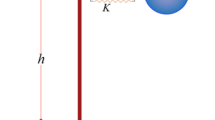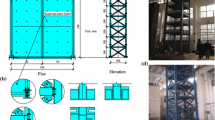Abstract
This study is devoted to investigate the effects of inertial soil–structure interaction (SSI) on the constant-strength inelastic displacement ratios of elastoplastic single-degree-of-freedom systems using a suit of 91 pulse-like ground motions. The soil beneath the foundation is simulated based on the cone model. A local minimum for the inelastic displacement ratios around the interacting system-to-pulse period ratio of one is demonstrated. Moreover, the soil flexibility increases the inelastic displacement ratios at all interacting system-to-pulse period ratios. However, the aspect ratio has decreasing and increasing effects on the inelastic displacement ratios before and after a threshold interacting system-to-pulse period ratio, approximately very close to one. It is confirmed that for slender structures, the SSI effects are the lowest at small interacting system-to-pulse period ratios and as this ratio increases, the SSI effects on the inelastic displacement ratios increase. However, for squat structures, the SSI approximately has more significant effects on the inelastic displacement ratios at lower interacting system-to-pulse period ratios and the effects decrease for higher interacting system-to-pulse period ratios. It is noted that the equal displacement rule is not valid as the SSI effects are taken into account. In addition, a formula is proposed to estimate the inelastic displacement ratios of soil–structure systems using nonlinear regression analysis, which is desirable for the displacement assessment of existing structures. Besides, the mean ratios of approximate-to-analytical values, very close to one, emphasize well accuracy of the proposed formula.










Similar content being viewed by others
Abbreviations
- SSI:
-
Soil-structure interaction
- SDOF:
-
Single-degree-of-freedom
- \(\hbox {C}_{\upmu }\) :
-
Constant-ductility inelastic displacement ratio
- \(\hbox {C}_{\mathrm{R}}\) :
-
Constant-strength inelastic displacement ratio
- \(\hbox {u}_{\mathrm{in}}\) :
-
Maximum inelastic lateral displacement
- \(\hbox {u}_{\mathrm{e}}\) :
-
Maximum elastic lateral displacement
- \(\hbox {u}_{\mathrm{y}}\) :
-
Maximum yielding lateral displacement
- \(\upmu \) :
-
Structural ductility ratio
- R:
-
Strength reduction factor
- \(\hbox {F}_{\mathrm{e}}\) :
-
Elastic lateral force
- \(\hbox {F}_{\mathrm{y}}\) :
-
Yielding lateral force
- \(\upalpha \) :
-
Post-elastic stiffness ratio
- \({\upxi }_{\mathrm{o}}\) :
-
Structural viscous damping
- \(\hbox {T}_{\mathrm{fix}}\) :
-
Vibration period of fixed-base structure
- \(\hbox {M}^{*}\) :
-
Effective mass of the structure in the first mode
- \(\hbox {I}^{*}\) :
-
Effective mass moment of inertia of the structure around its geometric center
- \(\hbox {h}^{*}\) :
-
Effective height of the structure in the first mode
- N:
-
Number of stories
- \(\hbox {C}_{\mathrm{m}}\) :
-
Effective mass coefficient
- \(\hbox {C}_{\mathrm{h}}\) :
-
Effective height coefficient
- r:
-
Radius of circular plan and foundation
- \(\hbox {K}_{\mathrm{fix}}^{*}\) :
-
Elastic stiffness of the fixed-base structure
- \(\hbox {m}_{\mathrm{f}}\) :
-
Foundation mass
- \(\hbox {I}_{\mathrm{f}}\) :
-
Mass moment of inertia of the foundation
- \(\hbox {A}_{\mathrm{f}}\) :
-
Area of the foundation
- \(\hbox {r}_{\mathrm{e}}\) :
-
Equivalent radius of the non-circular foundation
- DOF:
-
Degree-of-freedom
- s:
-
Sway degree-of-freedom of the foundation
- \({\upvarphi }\) :
-
Rocking degree-of-freedom of the foundation
- \(\uptheta \) :
-
Additional internal rotational degree-of-freedom
- \(\hbox {m}_{\uptheta }\) :
-
Polar mass moment of inertia of additional freedom
- \({\upupsilon }\) :
-
Soil Poisson’s ratio
- \(\hbox {V}_{\mathrm{a}}\) :
-
Soil axial-wave velocity
- \(\hbox {V}_{\mathrm{s}}\) :
-
Soil shear-wave velocity
- \(\Delta \hbox {M}_{{\upvarphi }}\) :
-
Trapped mass moment of inertia
- \(\hbox {k}_{\mathrm{s}}\) :
-
Sway stiffness coefficient of soil
- \(\hbox {k}_{{\upvarphi }}\) :
-
Rocking stiffness coefficient of soil
- \(\hbox {C}_{\mathrm{s}}\) :
-
Sway damping coefficient of soil
- \(\hbox {C}_{{\upvarphi }}\) :
-
Rocking damping coefficient of soil
- \(\uprho \) :
-
Mass density of soil
- \({\upomega }_{\mathrm{fix}}\) :
-
Circular frequency of fixed-base structure
- G:
-
Shear modulus of the soil
- \({\upxi }_{\mathrm{M}}\) :
-
Material damping of the soil
- \(\hbox {a}_{0}\) :
-
Non-dimensional frequency
- M:
-
Mass matrix of soil–structure system
- C:
-
Damping matrix of soil–structure system
- K:
-
Stiffness matrix of soil–structure system
- {U}:
-
Displacement vector of soil–structure system
- \(\hbox {u}_{\mathrm{g}}\)(t):
-
Input acceleration time history
- {r}:
-
Influence vector
- \(\hbox {u}^{*}\) :
-
Absolute displacement of soil–structure system
- \(\hbox {u}_{\mathrm{s}}\) :
-
Sway displacement of the foundation
- c:
-
Structure damping
- \(\hbox {T}_{\mathrm{p}}\) :
-
Pulse period
- \(\hbox {T}_{\mathrm{ssi}}\) :
-
Vibration period of soil–structure system
- \({\upbeta }\) :
-
Ratio of the \(\hbox {C}_{\mathrm{R}}\)-values resulting from the soil–structure systems to those obtained from the fixed-base structures
- \({\upbeta }_{\mathrm{ap}}\) :
-
Approximate value of \({\upbeta }\)
- \({\upbeta }_{\mathrm{an}}\) :
-
Analytical value of \({\upbeta }\)
- \(\hbox {E}_{\mathrm{m}}\) :
-
Mean ratio of \({\upbeta }_{\mathrm{ap}}\) to \({\upbeta }_{\mathrm{an}}\)
References
Ambrosini RD (2006) Material damping vs. radiation damping in soil–structure interaction analysis. Comput Geotech 3:86–92
ASCE/SEI 7-10 (2010) Minimum design loads for buildings and other structures. American Society of Civil Engineers, Reston
Aviles J, Perez-Rocha LE (2003) Soil-structure interaction in yielding systems. Earthq Eng Struct Dynam 32:1749–1771
Aviles J, Perez-Rocha LE (2011) Use of global ductility for design of structure–foundation systems. Soil Dyn Earthq Eng 31:1018–1026
Baker JW (2007) Quantitative classification of near-fault ground motions using wavelet analysis. Bull Seismol Soc Am 97(5):1486–1501
Bates DM, Watts DG (1988) Nonlinear regression analysis and its applications. Wiley, Hoboken
Bielak J (1978) Dynamic response of non-linear building-foundation systems. Earthq Eng Struct Dyn 7:17–30
Chopra AK, Gutierrez JA (1974) Earthquake response analysis of multistory building including foundation interaction. Earthq Eng Struct Dyn 3:65–77
Chopra AK, Chintanapakdee C (2006) Inelastic deformation ratios for design and evaluation of structures: single-degree-of-freedom bilinear system. J Struct Eng 130(9):1309–1319
FEMA 356 (2000) NEHRP pre-standard and commentary for the seismic rehabilitation of buildings. Federal Emergency Management Agency, Washington, DC
FEMA 440 (2005) Improvement of nonlinear static seismic analysis procedures, Applied Technology Council (ATC-55 project). Federal Emergency Management Agency, Washington, DC
Ghannad MA, Fukuwa N, Nishizaka R (1998) A study on the frequency and damping of soil–structure systems using a simplified model. J Struct Eng Archit Inst Jpn 44B:85–93
Ghannad MA, Ahmadnia A (2006) The effect of soil–structure interaction on the inelastic structural demands. Eur Earthq Eng 20(1):23–35
Iervolino I, Chioccarelli E, Baltzopoulos G (2012) Inelastic displacement ratio of near-source pulse-like ground motions. Earthq Eng Struct Dyn. doi:10.1002/eqe.2167
Khoushnoudian F, Ahmadi E (2013) Effects of pulse period of near-field ground motions on the seismic demands of soil-MDOF structure systems using mathematical pulse models. Earthq Eng Struct Dyn. doi:10.1002/eqe.2287
Kramer SL (1996) Geotechnical earthquake engineering. Prentice-Hall, Englewood Cliffs
Meek W, Wolf JP (1993) Why cone models can represent the elastic half-space. Earthq Eng Struct Dynam 22:759–771
Meek W, Wolf JP (1994) Material damping for lumped-parameter models of foundation. Earthq Eng Struct Dynam 23:349–362
Miranda E (1993) Evaluation of site dependent inelastic seismic design spectra. J Struct Eng ASCE 119(5):1319–1338
Miranda E (2000) Inelastic displacement ratios for structures on firm sites. J Struct Eng ASCE 126(10):1150–1159
Muller FP, Keintzel E (1982) Ductility requirements for flexibly supported antiseismic structures. In: Proceedings of the 7th European conference on earthquake engineering
Nakhaei M, Ghannad MA (2008) The effect of soil–structure interaction on damage index of buildings. Eng Struct 30:1491–1499
Nassar AA, Krawinkler H (1991) Seismic demands for SDOF and MDOF systems, report no. 95, John A. Blume Earthquake Engineering Center, Stanford University, Stanford
Novak M (1974) Effect of soil on structural response to wind and earthquake. Earthq Eng Struct Dyn 3:79–96
Rodriguez ME, Montes R (2000) Seismic response and damage analysis of buildings supported on flexible soils. Earthq Eng Struct Dyn 29:647–665
Ruiz-Garcia J (2011) Inelastic displacement ratios for seismic assessment of structures subjected to forward-directivity near fault ground motions. J Earthq Eng 15(3):449–468
Ruiz-Garcia J, Miranda E (2003) Inelastic displacement ratios for evaluation of existing structures. Earthq Eng Struct Dyn 32:1237–1258
Ruiz-Garcia J, Miranda E (2004) Inelastic displacement ratios for design of structures on soft soils site. J Struct Eng 130(12):2051–2061
Ruiz-Garcia J, Miranda E (2006) Inelastic displacement ratios for evaluation of structures built on soft soil sites. Earthq Eng Struct Dyn 35:679–694
Seylabi E, Jahankhah H, Ghannad MA (2012) Equivalent linearization of non-linear soil–structure interaction. Earthq Eng Struct Dyn. doi:10.1002/eqe.2156
Veletsos AS, Newark NM (1960) Effect of inelastic behavior on the response of simple systems to earthquake motions. In: 2nd world conference on earthquake engineering, Tokyo, vol 2, pp 895–912
Veletsos AS, Van WP (1971) Response of ground-excited elastoplastic systems. J Struct Div ASCE 97(4):1257–1281
Veletsos AS (1977) Dynamic of structure-foundation systems. In: Hal WJ (ed) Structural and geotechnical mechanics. Prentice-Hall, Englewood Cliffs (NJ), pp 333–361
Wolf JP (1994) Foundation vibration analysis using simplified physical models. Prentice Hall, Englewood Cliffs
Wolf JP, Deeks AJ (2004) Foundation vibration analysis: a strength-of-materials approach. Elsevier, Amsterdam
Author information
Authors and Affiliations
Corresponding author
Rights and permissions
About this article
Cite this article
Khoshnoudian, F., Ahmadi, E. Effects of inertial soil–structure interaction on inelastic displacement ratios of SDOF oscillators subjected to pulse-like ground motions. Bull Earthquake Eng 13, 1809–1833 (2015). https://doi.org/10.1007/s10518-014-9693-y
Received:
Accepted:
Published:
Issue Date:
DOI: https://doi.org/10.1007/s10518-014-9693-y




